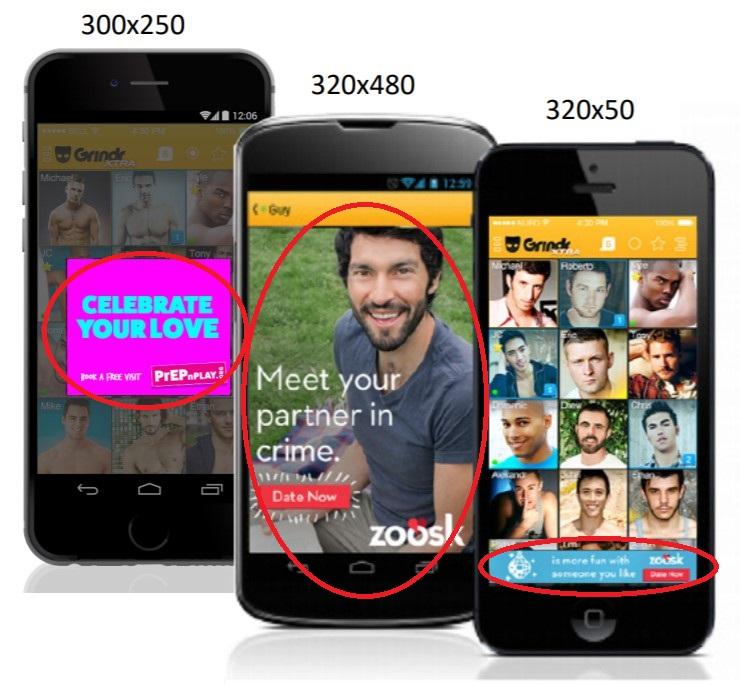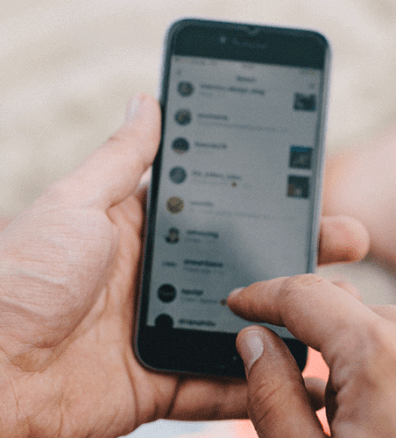Digital Campaign Execution - Webinar (10/13/20)
Intro to Ad Buying on Apps
RDW has worked with the Rhode Island Department of Health, as well as Building Healthy Online Communities, in using digital media to encourage gay men to get tested for HIV and STDs. RDW offers its expertise in helping each organization evaluate their budget and recommend the best media plan to meet their goals.
The benefits of using a single point of contact such as a media agency for media planning and buying include greater efficiency and cost savings. Knowing the key sites/apps and what they have to offer, knowing what has been successful in the past as well as the experience needed to manage a budget and negotiate rates are all keys to success. The outline below is meant to give you the basic information about how to buy online media.
Purchasing advertisements online is more time and cost-efficient when you know the basic steps involved.
The first thing you need to do is define your goal. Key questions for you to consider include:
1. |
What action do you want users to take?
Each ad should have a clear cue to action. RDW worked with BHOC to purchase ads to promote HIV and STD testing on sites and apps. After clicking on the ads, viewers were taken to gettested.cdc.gov, where they could input their zip code to find a testing site near them. |
2. |
What is your budget, and what are your geographic priorities?
When you purchase online ads, you are actually purchasing the number of impressions. Impressions represent the number of times an ad appears on a website or app. Each time an ad appears, it is counted as one impression. Based on how much of a budget you have, you’ll need to decide whether you have enough funds to place ads throughout the entire country or state or focus on smaller geographic markets so that you are able to purchase a higher percentage of each site or app’s impressions among all advertisers in each market. This is known as “share of voice,” or SOV. The cost per thousand impressions (CPMs) will vary by dating site by site, but within each site, not market by market. Unlike buying a television ad, where the cost will be much higher in a major city than a rural area, CPM’s do not vary by location. However, there may not be as many impressions available to purchase in a major city since there may be many more purchasers buying ad space. Sites and apps can, however, sell ads in a specific geographic area, and you’ll have a better chance of earning a higher SOV than if you were to buy national ads. In short: a smaller budget will go further in specific geographic areas than trying to reach a nationwide audience. However, some online apps/sites don’t offer geographic targeting at all. While there isn’t necessarily a direct correlation between budget spent and the action you want people to take, it is important to have a strong SOV to expose as many people in our target audience as possible to our message, ideally more than once, and ultimately take action. For example, a $5,000 budget may only allow you to purchase ads on one site for a short period of time, while a $100,000 budget will allow you to purchase ads on more sites for a longer period. |
3. |
What ad sizes do you need? It is important to provide banners and pop-up ads that are sized and built to meet each site or app’s requirements. Most sites follow standardized guidelines. Some of the smaller sites don’t follow these guidelines, and may require ads to be in other sizes or formats. There may be a need for an additional size for some of the smaller sites which don’t adhere to these guidelines. |
4. |
How much ad space is available?
A media buyer such as RDW will ask sites and apps how many impressions are available for purchase. After assessing your needs and budget, RDW will compile a list of sites/apps to request proposals from then will ask each site for their best proposal for how much advertising they can make available and what percentage that is of their total number of impressions within that timeframe. |
5. |
How can you evaluate your ad placement?
It’s important to consider ahead of time what you want to measure. In some instances, you’ll just want to know how many people clicked on an ad. In others, you will want to know how many took an action such as entering their zip code. |
The next step in planning the campaign is to establish mechanisms that can be used to evaluate it:
Each advertisement can be assigned an Urchin Tracking Module (UTM). These UTM codes allow you to track each site’s success by measuring what a viewer does after they have clicked on the advertisement. They also guide the “back-end metrics” which are analyzed through Google Analytics (GA). These actions may include how much time they spent looking at the information on the site, how many pages they viewed, or if they leave the site immediately after clicking on it. When encouraging viewers to go to gettested.cdc.gov, for example, these codes enabled us to attribute to each site the advertisement that resulted in the viewer taking an action, such as entering their zip code. (More information on Google Analytics). All this allows you to measure which ad, on which site, gives you the result you want.
By periodically tracking the advertisements’ performance during the campaign, the media purchaser can optimize the placement of advertisements which are having the most success, and reduce the placement of those which are having less. However, most sites require a two-week cancellation request. If you’re running an ad for only a month, you may not have enough data to alter that month’s purchase or have enough data to properly evaluate. However, the good news is that you’ll have more information to inform your future campaigns.
In order to get an objective, unbiased report of impressions and clicks, media buyers frequently contract with a third-party ad server, such as Doubleclick (which is also owned by Google). Third-party ad servers use tracking pixels attached to the banners to verify that sites are delivering the impressions that you purchased. However, some key dating sites and apps do not allow third-party tracking. In these cases, as part of the purchase with each site, metrics should be negotiated that both parties can agree upon.
Mobile and app tracking can at times present another set of challenges since cookies are often blocked by default on most mobile platforms, but you can still ask sites for data on a given ad.
Below is a list of many of the different sites and apps, their contact for advertisements, as well as whether or not they accept third-party servers. It also includes which sites accept nudity in their advertising.
(Spreadsheet Coming Soon!)
For more information about ad purchases, feel free to contact RDW at media@rdwgroup.com.
Ad Buying Info From Apps
Adam4Adam
Media Kit 2020
Growlr
Advertising Info
Hornet
Media Kit 2021
Manhunt
Media Kit 2020
Squirt
Media Kit 2020
Scruff + Jack’d
Advertising Info
Grindr
Grindr for Equality Broadcasting Partnership
Media Kit
Grindr Advertising Rates
Available creative types on Grindr’s Self-Serve platform:
Standard Mobile Banner 320×50
Mobile Interstitial 320×480
Medium Rectangle 300×250
File Types accepted: JPEG, JPG, GIF, PNG (Max file size 500Kb)
CPM rates:
Banner
US $2.50
UK, Canada $2.00
EU, Israel, & Australia $1.50
Rest of World $1.00
Interstitial
US, UK, Canada $15.00
EU, Israel, & Australia $10.00
Rest of World $6.00
Medium Rectangle
US, Canada $10
EU, Australia, Japan, Israel, Middle East, HK, Singapore $6.00
Rest of World $4.00
All rates are in CPM and in US dollars, so that means that $15 is for 1000 impressions per day not per click. Impressions = views to your banner.
CPM is the cost for 1,000 views on your banner.
There is no minimum spend and you can choose how much to spend on a daily basis.
To open an account, register at https://selfservice.grindr.com/signup/advertiser
After creating an account and once logged in, Grindr suggests visiting the “How to Guide” ( https://selfservice.grindr.com/howto ) to get campaigns started right away.
The Grindr Support team is available to answer questions at: support@selfservice.grindr.com
2022 Recommendations for Maximizing Effectiveness of Online Ads to Promote Sexual Health and Wellness
Practical keywords for targeting MSM when advertising online
Advertising Terms - Glossary
Common terms to know when advertising online
- Ad network – A vendor that connects advertisers to publishers. Ad networks act as a single point of contact between publishers and advertisers, helping negotiate supply and demand. Google Ads is an example of an ad network because advertisers can purchase ads on millions of websites through it without having to negotiate rates with each site individually.
- Ad unit – The specific size and placement of an ad
- Affinity group – A group of people that share a goal or interest based on their online behavior used for defining and targeting an audience on digital platforms like Google and Facebook.
- Audience – The people to whom ads are being shown
- Building an audience – Gaining insights into digital behaviors that make someone more likely to be interested in a specific message or to take a desired action based on email lists, site visitors or other keyword or affinity group data from past campaigns
- Conversion – Desired actions someone took based seeing an ad (i.e. Clicks, form fills, find a clinic, etc.)
- Conversion rate – The rate at which people who saw an ad take the action that the advertiser wanted (Conversions/Impressions)
- CPC (Cost Per Click) – The cost paid for a single click on an ad. This is a common pricing model for digital ads and often a metric used to compare the efficiency of two different media types. A Google display CPC of $0.25 means an advertiser is paying $0.25 for each click on a banner ad shown via Google’s ad network.
- CPM (Cost per thousand impressions) – In media, “M”, in this instance, stands for 1000. The cost paid to show an ad 1000 times. This is a common pricing model for digital ads and often a metric used to compare the efficiency of two different media types. A Facebook CPM of $10 means it cost $10 to show an ad 1000 times to an audience on Facebook.
- Creative – The ad(s) that an advertiser is running
- CTR (Click Through Rate) – Average number of clicks on an ad per hundred times it is seen, expressed as a percentage.
- Frequency – The number of times each person sees any one ad
- Impressions – The number of times any one ad was seen (Reach x Frequency)
- Optimal frequency – The number of times an advertiser needs to show any one ad to each member of an audience to get them to take action at the lowest cost.
- Placement – Where an ad is shown or “placed.”
- Reach – The number of people that see an ad
- Retargeting – Refers to buying ads that target individuals who have previously visited a campaign’s website. Retargeting enables an increase in conversion rate (or action taken) by reaching individuals who have previously demonstrated interest in a given message by clicking on an ad in the past.
- Spend – The amount of money an advertiser will spend on media (aka Media Budget)
- Targeting – The parameters used to define an audience
Courtesy of Matt Moss at Water & Stone Marketing
Media Budget Calculator
Input your data to calculate media budgets (Note: “Enable Editing” to interact with calculator)
Dating App Inventory
Our dating app inventory compiles top-level information relevant to public health jurisdictions wanting to reach MSM through dating apps.
MSM Dating App Inventory Updated: March 4, 2021
Webinars - Using Online Media in Ending the HIV Epidemic work
Campaign Execution – How to use online media in your Ending the HIV Epidemic work (1/3)
Social media and other online platforms, like Google, Facebook, and Instagram, are critical to promoting health literacy among the public in the HIV response. With the number of different webpages, apps, and other platforms, it is important for health department communications staff to think strategically about which media platforms to use to promote their messaging.
Building Healthy Online Communities (BHOC), a coalition to strengthen relationships between public health organizations and dating apps, of which NASTAD is a member, facilitated this webinar introducing introductory concepts on digital marketing with expert Matthew Moss of Water & Stone Marketing.
Additional BHOC materials:
Practical keywords for targeting MSM when advertising online
Recommendations for improving effectiveness of online ads to promote sexual health
This webinar is 1 of a 3 part series.
____________________________________
Digital Advertising on a Limited Budget (2/3)
Social media and other online platforms, like Google, Facebook, Grindr, and Instagram, are critical to promoting access to health resources and information among the public in the HIV response. With the number of different webpages, apps, and other platforms, it is important for health department communications staff to think strategically about which media platforms to use to promote their messaging.
This is especially true for health departments and organizations with limited resources for purchasing ad spaces and graphic designs. This webinar focused on how health departments can maximize their resources in implementing online outreach programs.
Building Healthy Online Communities, a coalition to strengthen relationships between public health organizations and dating apps, of which NASTAD is a member, facilitated this webinar with digital marketing expert Matthew Moss of Water & Stone Marketing.
This webinar is one of a series to promote digital marketing in the HIV response. The previous webinar recording and slides can be found here.
Additional BHOC materials:
Practical keywords for targeting MSM when advertising online
Recommendations for improving effectiveness of online ads to promote sexual health
This webinar is 2 of a 3 part series.
____________________________________
How to Buy an Online Ad – A Step By Step Guide (3/3)
With the number of different webpages, apps, and other platforms, it is important for health department communications staff to think strategically about which media platforms to use to promote their messaging.
This is especially true for health departments and organizations with limited resources for purchasing ad spaces and graphic designs. This webinar will focus on how health departments buy an online ad – including all the details needed to effectively plan, manage, and monitor the ad.
Facilitated by digital marketing expert Matthew Moss of Water & Stone Marketing, this webinar is one of a three-part series to promote digital marketing in the HIV response. The previous two webinar recordings and slides can be found here.
Digital Graphic Ad Sizes
Campaign Effectiveness Tips from Grindr


